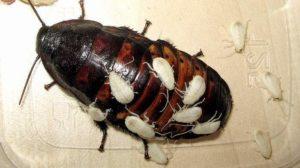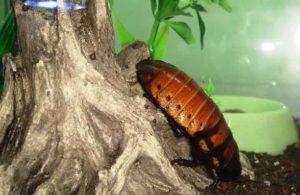Madagascar cockroach: the nature and characteristics of the African beetle
At the sight of cockroaches, people most often experience disgust. They are unpleasant, carry many diseases and live in garbage. But among the large number of these pests, there is a rather charming Madagascar cockroach.
Content
What does an African cockroach look like?
Description of the Madagascar cockroach
Name: Madagascar cockroach
Latin: Gromphadorhina portentosaClass: Insects - Insecta
Squad: Cockroaches - Blattodea
 | Habitats: | tropical forests of Madagascar |
 | Dangerous for: | does no harm |
 | Attitude towards people: | raised as pets |
Description of the African cockroach
African cockroaches differ from their relatives in large body sizes. They do not have wings, and in case of danger they make whistling sounds, scaring off enemies. But this characteristic does not scare away, but on the contrary, makes Madagascar an attractive pet.
The male African cockroach reaches a length of up to 60 mm, and the female is up to 55 mm; in the tropics, some specimens can reach up to 100-110 mm. The front part of the body is colored brown-black, the main color is brown. But the older the imago, the lighter the color becomes. On the prothorax, the male has two raised horns. This species has no wings in either the male or the female. They are not venomous and do not bite. They lead mainly a nocturnal lifestyle.
In nature, the life span of hissing cockroaches is 1-2 years, in captivity they live 2-3 years, some individuals, with good care, live up to 5 years.
Cockroach "mute"
Respiratory pores are slightly modified, which allows you to make an unusual sound, hissing. It forcibly displaces air, which makes it so unique, unlike others. Males use this sound more often. And in several different tones, depending on the needs.
The male gender has its own territory. It may even be the smallest stone, but the male can sit on it for several months guarding, descending only to find food.
In case of danger, African cockroaches begin to make loud hissing sounds. In the "battle" in terms of sound, the one who is the loudest wins.
In the process of flirting, the male sex makes sounds in different tonalities. At the same time, they still stand on their hind limbs.
Females are more sociable and less aggressive. They rarely make loud noises. But in the colonies there are situations of hissing in unison. Then sounds are emitted by both sexes. But the reasons for such an event have not yet been studied.
Habitat
The African or Madagascar hissing cockroach lives in the rainforests of Madagascar. This species in wildlife is found on the branches of trees and shrubs, as well as in damp litter of overripe leaves and pieces of bark.
These insects are not pests and do not enter people's homes by accident. Muteers do not like cold, become lethargic and lifeless.
Reproduction
To attract a female, the male tries to hiss loudly. Its long whiskers serve as pheromone receptors. Therefore, when two males fight in the fight for a female, they first of all try to leave the opponent without a mustache.
Fertilized females carry a pregnancy of 50-70 days, newborn larvae are white, and 2-3 millimeters in length. Up to 25 larvae can appear in a female at one time. Babies are with their mother for several days, and then begin an independent life.
Food
African cockroaches living in nature feed on greens, fruits, bark residues. This species in the natural environment are useful - they process rotting plants, carrion and animal carcasses.
When bred at home, they can be given any food that the owners eat. The main thing is that there is enough food freely available, otherwise they will start to eat each other. It could be:
- bread;
- fresh vegetables;
- fruit;
- cereals without salt and spices;
- boiled corn;
- grass and greens;
- flower petals;
- food for dogs or cats.
Breeding cockroaches at home
Basically, Madagascar cockroaches are grown as food for lizards and snakes. But some exotic lovers breed hissing cockroaches as pets. They live and breed in a warm and humid container with an air temperature of +25-+28 degrees and a humidity of no more than 70 percent.
The lid should be perforated for ventilation. At the bottom, you can pour sawdust or coconut flakes. In order for cockroaches to hide in the daytime, you need to equip shelters. You can buy them at the store or make your own from what you have at home. At the bottom, place a drinking bowl in which to put pieces of cotton wool so that the cockroaches do not drown.
Several rules require special attention:
- The container must be closed. Although they cannot fly, they actively crawl.
- A transparent lid and walls are great - the animals are interesting to watch.
- Cockroaches do not like anything superfluous, foreign objects can irritate them, they show aggression.
- Bark or driftwood is required to shelter the animal.
- Make sure that there is always water and enough food in the drinker.
- Change the bedding once a month.
- Maintain the temperature in the container, otherwise the cockroaches will grow and develop poorly.
Madagascar cockroaches and people
Pets from African individuals are excellent. Cockroaches living at home quickly get used to a person, they can be picked up. They respond well to affection and even express something like affection. An escaped African cockroach in a human dwelling does not take root and does not give offspring.
Conclusion
The African or Madagascar hissing cockroach is an exotic insect. It lives in wildlife and can be bred at home. An interesting large insect that hisses in case of danger or during the mating season. Not picky about the conditions of detention and can become a favorite pet.
Previous

